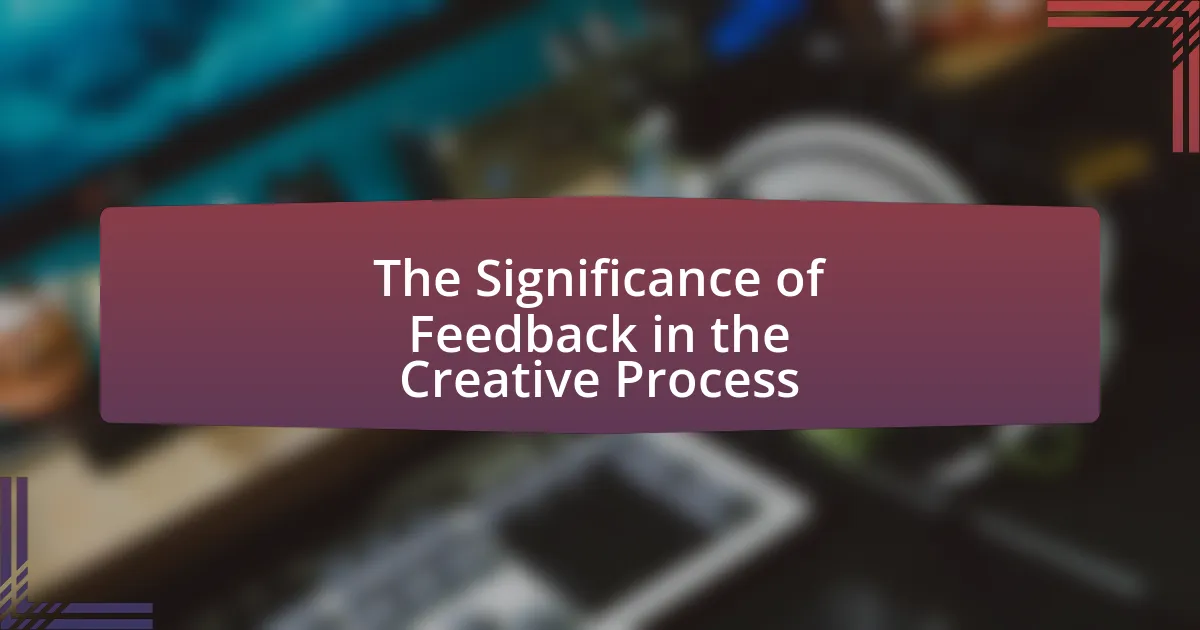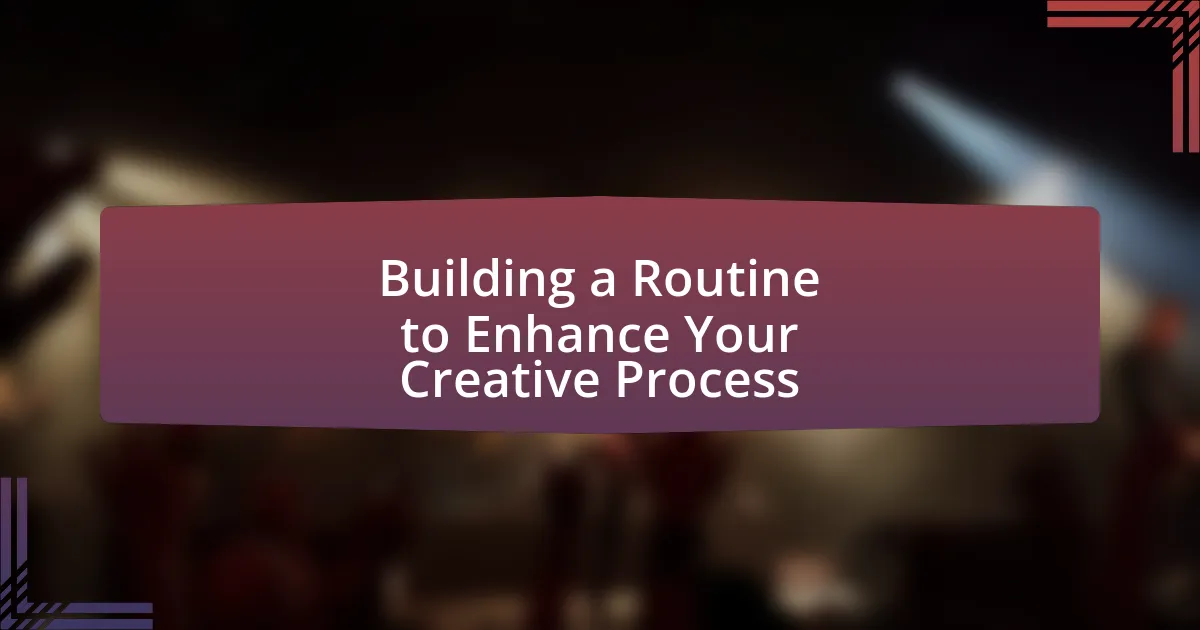The article examines the influence of genre on the creative process across various artistic fields, including literature, visual arts, and music. It highlights how genre shapes expectations, themes, and structures, guiding creators in their storytelling and artistic choices. Key characteristics of genres, such as conventions and audience expectations, are discussed in relation to their impact on creativity and decision-making. The article also addresses the challenges creators face when adhering to genre norms, the importance of genre awareness for enhancing creative output, and strategies for innovation within and across genres.
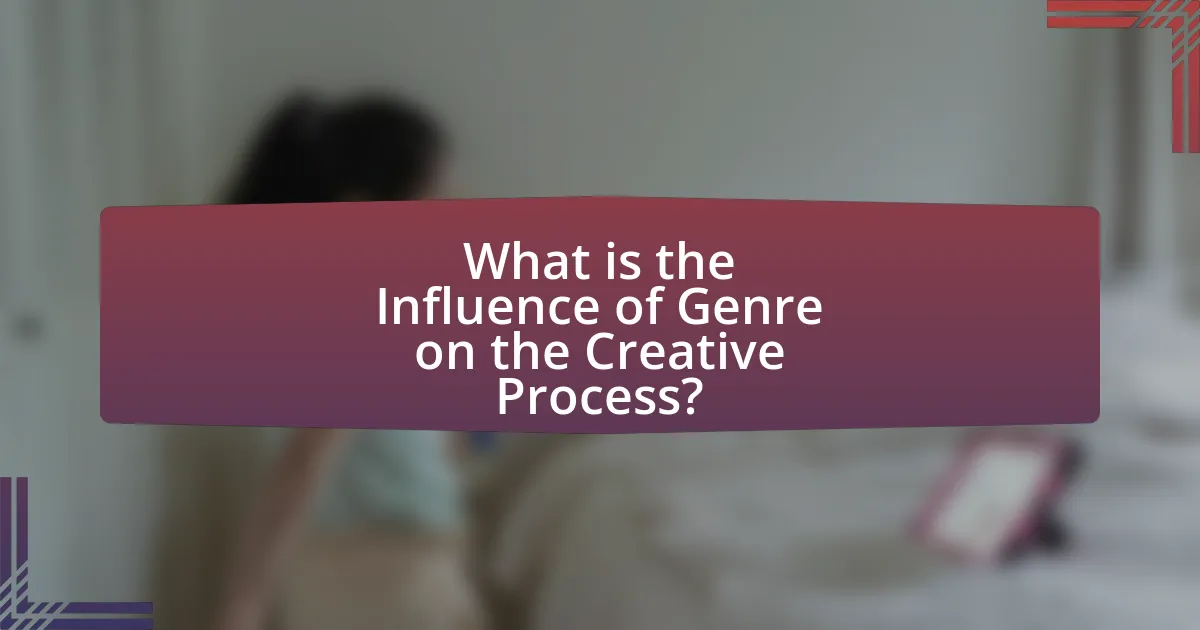
What is the Influence of Genre on the Creative Process?
Genre significantly influences the creative process by shaping the expectations, themes, and structures that creators utilize in their work. Different genres provide specific conventions and tropes that guide artists in their storytelling, character development, and stylistic choices. For instance, in literature, the mystery genre often requires a focus on suspense and plot twists, while romance emphasizes emotional connections and character relationships. This genre-specific framework not only helps in organizing ideas but also influences audience reception, as viewers or readers come with preconceived notions based on genre norms. Research by David H. Hargreaves in “The Psychology of Music” indicates that genre familiarity can enhance emotional engagement and cognitive processing, further validating the impact of genre on creativity.
How does genre shape the creative process in different artistic fields?
Genre significantly shapes the creative process in different artistic fields by providing a framework that influences the themes, structures, and techniques employed by artists. In literature, for example, genre dictates narrative style and character development; a romance novel typically focuses on emotional relationships, while a thriller emphasizes suspense and plot twists. In visual arts, genre influences subject matter and stylistic choices; realism aims to depict subjects accurately, while abstract art prioritizes expression over representation.
Moreover, in music, genre determines instrumentation, rhythm, and lyrical content; pop music often features catchy melodies and relatable themes, while classical music may focus on complex compositions and orchestration. This genre-specific guidance helps artists navigate their creative processes, ensuring that their work resonates with audiences familiar with those conventions. The adherence to genre conventions can also foster innovation, as artists may choose to subvert or blend genres to create unique expressions, thus pushing the boundaries of their respective fields.
What are the key characteristics of various genres that impact creativity?
The key characteristics of various genres that impact creativity include structure, conventions, themes, and audience expectations. Structure dictates how a narrative unfolds, influencing the creative choices available to the creator; for example, a linear structure in a novel allows for detailed character development, while a non-linear structure in film can enhance suspense. Conventions, such as genre-specific tropes, guide creators in their storytelling but can also limit innovation if adhered to rigidly. Themes prevalent in genres, like love in romance or conflict in action, shape the emotional resonance and depth of creative works. Audience expectations, which vary by genre, can either inspire creators to meet these anticipations or challenge them to subvert norms, fostering originality. These characteristics collectively shape the creative landscape, as evidenced by the diverse approaches seen in literature, film, and music across genres.
How do genre conventions influence the decision-making of creators?
Genre conventions significantly influence the decision-making of creators by providing a framework that guides narrative structure, character development, and thematic elements. These conventions help creators align their work with audience expectations, ensuring that the content resonates with viewers or readers familiar with specific genres. For instance, in horror films, the use of suspenseful music and jump scares is a convention that creators employ to evoke fear, as evidenced by the success of films like “The Conjuring,” which adheres to established horror tropes. By following these conventions, creators can effectively communicate their intended messages and engage their target audience, ultimately impacting the commercial viability and critical reception of their work.
Why is understanding genre important for creators?
Understanding genre is crucial for creators because it shapes audience expectations and guides the creative process. By recognizing the conventions and characteristics of specific genres, creators can effectively communicate their ideas and connect with their target audience. For instance, a study published in the Journal of Creative Behavior highlights that creators who align their work with genre conventions are more likely to achieve commercial success, as audiences often seek familiar elements in storytelling. This understanding allows creators to innovate within established frameworks while still meeting audience preferences, ultimately enhancing both engagement and satisfaction.
How does genre awareness enhance the creative output?
Genre awareness enhances creative output by providing a framework that guides creators in structuring their work effectively. Understanding the conventions and expectations of a specific genre allows artists, writers, and musicians to innovate within those boundaries while still appealing to their audience. For instance, a study published in the Journal of Creative Behavior found that writers who were aware of genre conventions produced more coherent and engaging narratives compared to those who were not. This indicates that genre awareness not only informs the creative process but also improves the overall quality and reception of the work.
What role does genre play in audience expectations and reception?
Genre significantly shapes audience expectations and reception by establishing a framework of conventions and tropes that viewers anticipate. For instance, a horror film typically leads audiences to expect suspenseful moments, jump scares, and a sense of dread, while a romantic comedy sets the expectation for humor, romance, and a happy resolution. Research indicates that these genre conventions influence how audiences interpret narratives and characters, as they rely on familiar patterns to make sense of the story. According to a study published in the Journal of Media Psychology, genre familiarity enhances viewer engagement and satisfaction, as audiences feel validated in their expectations when a film adheres to its genre norms. Thus, genre plays a crucial role in guiding audience perceptions and emotional responses to media.
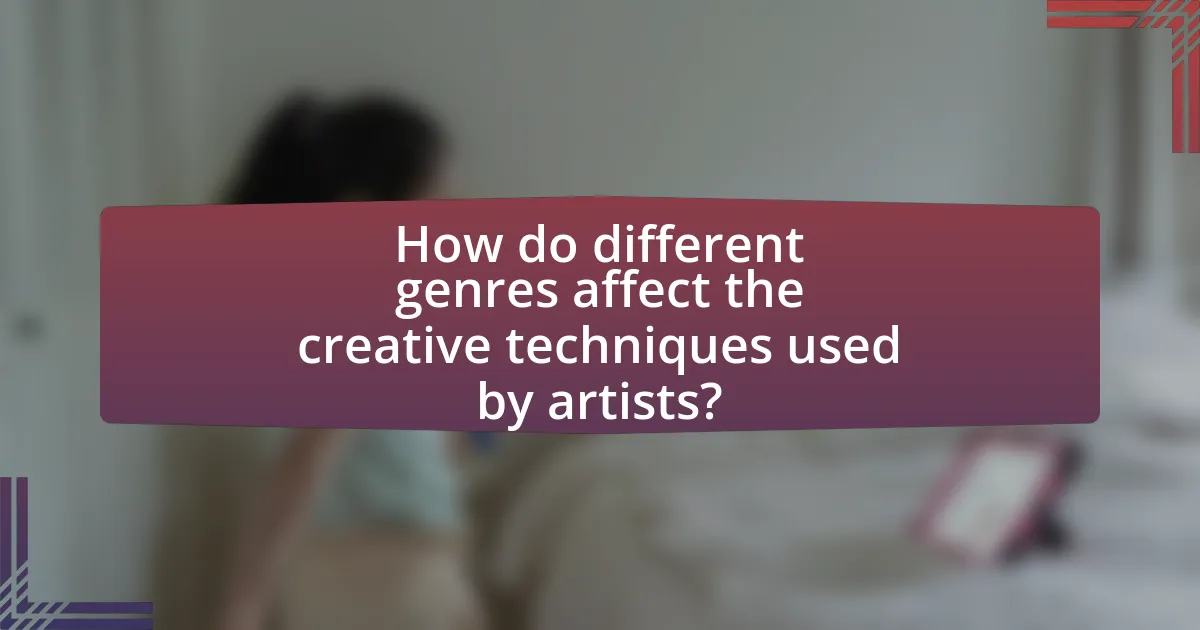
How do different genres affect the creative techniques used by artists?
Different genres significantly influence the creative techniques employed by artists by dictating stylistic choices, thematic elements, and methods of expression. For instance, in visual arts, realism requires meticulous attention to detail and accurate representation, while abstract art encourages experimentation with form and color, allowing for more subjective interpretations. In literature, genres like science fiction often utilize speculative techniques to explore futuristic concepts, whereas historical fiction relies on research and authenticity to create believable narratives. These genre-specific demands shape how artists approach their work, leading to distinct methodologies and outcomes that reflect the conventions and expectations of each genre.
What specific techniques are influenced by genre in writing?
Specific techniques influenced by genre in writing include narrative structure, character development, and stylistic choices. For instance, in mystery genres, writers often employ red herrings and cliffhangers to maintain suspense, while in romance, emotional arcs and relationship dynamics are emphasized. Additionally, genres like science fiction frequently utilize world-building techniques to create immersive settings, whereas horror relies on pacing and atmosphere to evoke fear. These techniques are tailored to meet the expectations and conventions of each genre, guiding writers in their creative process.
How do genre-specific tropes guide narrative structure?
Genre-specific tropes guide narrative structure by providing established conventions that shape plot development, character arcs, and thematic elements. These tropes create expectations for audiences, influencing how stories are constructed and perceived. For instance, in the romance genre, the “meet-cute” trope establishes a framework for how romantic relationships begin, guiding the narrative toward conflict and resolution. Similarly, in the horror genre, the “final girl” trope dictates character survival patterns and plot progression, leading to a climax that typically involves a confrontation with the antagonist. These conventions not only streamline storytelling but also enhance audience engagement by aligning with familiar patterns, thereby reinforcing the effectiveness of the narrative structure.
What are the common stylistic choices associated with different genres?
Common stylistic choices associated with different genres include specific narrative structures, tone, language, and thematic elements. For instance, in the mystery genre, authors often employ a suspenseful tone, intricate plots, and red herrings to engage readers. In contrast, romance novels typically feature emotional language, character-driven narratives, and themes of love and relationships. Science fiction often incorporates speculative language, futuristic settings, and complex world-building to explore technological and societal issues. These stylistic choices are not arbitrary; they align with reader expectations and genre conventions, which have been established through historical trends and audience preferences.
How do visual artists adapt their methods based on genre?
Visual artists adapt their methods based on genre by altering their techniques, materials, and conceptual approaches to align with the specific characteristics and expectations of each genre. For instance, a painter working in realism focuses on accurate representation and detail, often using traditional oil paints and techniques to achieve lifelike effects. In contrast, an abstract artist may prioritize color, form, and emotional expression, utilizing mixed media or unconventional materials to convey their vision. This adaptation is evident in the historical evolution of art movements; for example, Impressionists shifted from detailed brushwork to looser, more spontaneous strokes to capture the essence of light and movement. Such genre-specific adaptations reflect the artists’ responsiveness to the thematic and stylistic demands inherent in different artistic categories.
What techniques are unique to genres like realism versus abstract art?
Realism employs techniques such as detailed observation, accurate representation of subjects, and the use of perspective to create lifelike images, while abstract art utilizes techniques like simplification, distortion, and the exploration of color and form to convey emotions or concepts rather than depict reality. Realism focuses on capturing the world as it is, often using techniques like chiaroscuro to enhance depth and realism, as seen in the works of artists like Gustave Courbet. In contrast, abstract art, exemplified by artists like Wassily Kandinsky, emphasizes the use of non-representational forms and colors to evoke feelings, often disregarding traditional composition and perspective.
How does genre dictate the use of color and composition in visual arts?
Genre significantly influences the use of color and composition in visual arts by establishing thematic expectations and emotional responses. For instance, in romantic art, warm colors and soft compositions evoke feelings of intimacy and passion, while in abstract art, bold colors and dynamic compositions can express chaos or freedom. Historical context supports this; for example, the Impressionist movement utilized light and color to capture fleeting moments, reflecting the genre’s focus on perception and experience. Thus, the specific characteristics of a genre guide artists in their choices of color palettes and compositional structures to effectively communicate their intended message.
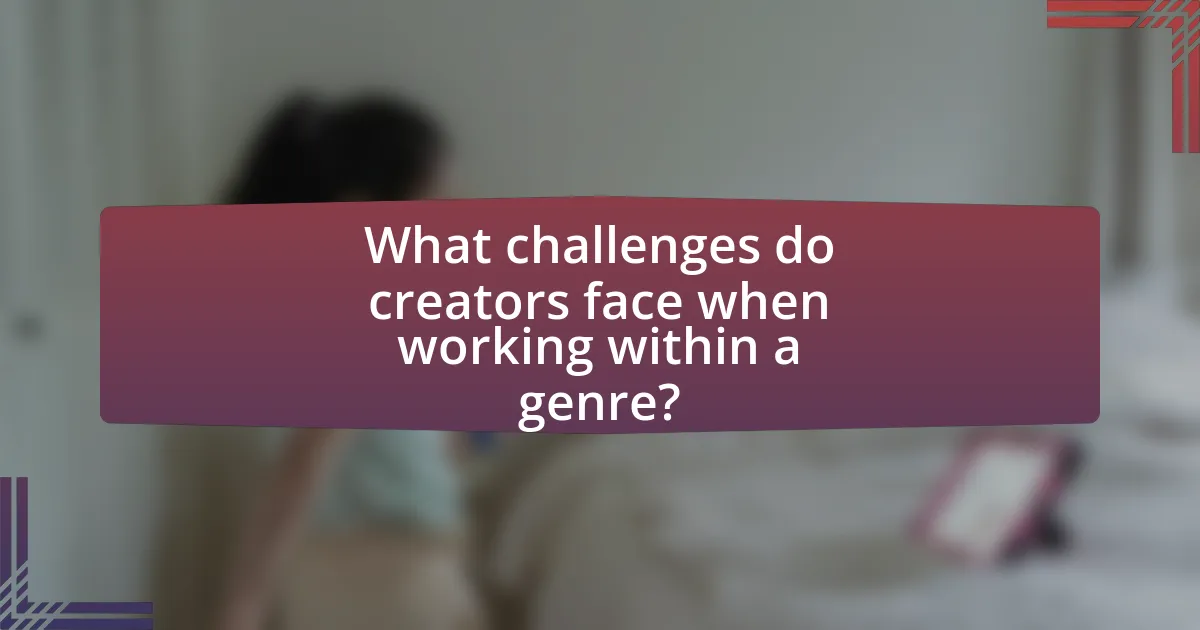
What challenges do creators face when working within a genre?
Creators face several challenges when working within a genre, primarily including the constraints of audience expectations, the risk of cliché, and the difficulty of innovation. Audience expectations dictate that creators adhere to specific conventions, which can limit creative freedom and lead to repetitive storytelling. The risk of cliché arises when creators rely too heavily on established tropes, potentially resulting in unoriginal work that fails to engage audiences. Additionally, the challenge of innovation is significant, as creators must find ways to introduce fresh ideas while still aligning with genre norms. These challenges are evident in various creative fields, such as film and literature, where genre conventions can both guide and restrict the creative process.
How can genre constraints limit creativity?
Genre constraints limit creativity by imposing specific rules and expectations that creators must adhere to, which can stifle innovation and originality. For instance, in literature, genres like romance or horror have established tropes and structures that writers often feel compelled to follow, potentially leading to formulaic storytelling. Research by David H. Hargreaves in “The Psychology of Music” indicates that adherence to genre conventions can restrict the exploration of new ideas, as creators may prioritize fitting within a genre over experimenting with unique concepts. This limitation can result in a lack of diversity in creative outputs, as artists may avoid taking risks that deviate from established norms.
What are the risks of being too rigid in genre adherence?
Being too rigid in genre adherence can stifle creativity and limit innovation in artistic expression. When creators strictly follow genre conventions, they may miss opportunities to explore unique ideas or blend elements from different genres, which can lead to repetitive and uninspired work. For instance, a study published in the Journal of Creative Behavior found that artists who experimented beyond their established genres reported higher levels of satisfaction and originality in their work. This indicates that flexibility in genre can enhance creative outcomes, while rigidity can hinder artistic growth and audience engagement.
How can creators balance genre expectations with personal expression?
Creators can balance genre expectations with personal expression by integrating unique elements into established frameworks while adhering to core genre conventions. This approach allows creators to maintain audience engagement through familiar structures while infusing their individual voice and perspective. For instance, a filmmaker might utilize traditional narrative arcs typical of a thriller but incorporate unconventional character development or thematic exploration that reflects their personal experiences. This method not only satisfies genre expectations but also enriches the work with authenticity, as seen in films like “Get Out,” where Jordan Peele combined horror with social commentary, successfully appealing to genre fans while expressing his unique viewpoint.
What strategies can artists use to innovate within their genres?
Artists can innovate within their genres by experimenting with cross-genre collaborations, utilizing new technologies, and incorporating diverse cultural influences. Cross-genre collaborations allow artists to blend elements from different styles, creating unique sounds or visuals that challenge traditional genre boundaries. For example, the collaboration between country artist Lil Nas X and rapper Billy Ray Cyrus on “Old Town Road” redefined genre expectations and achieved massive commercial success.
Utilizing new technologies, such as digital audio workstations or virtual reality, enables artists to explore innovative production techniques and presentation formats. The rise of platforms like TikTok has also encouraged artists to create shorter, more engaging content that resonates with contemporary audiences, further pushing genre innovation.
Incorporating diverse cultural influences can lead to fresh perspectives and new artistic expressions. Artists like Bad Bunny have successfully integrated reggaeton with elements of rock and pop, expanding the genre’s reach and appeal. These strategies demonstrate how artists can effectively innovate within their genres while remaining relevant in a rapidly evolving creative landscape.
How can blending genres lead to new creative opportunities?
Blending genres can lead to new creative opportunities by fostering innovation and expanding the range of artistic expression. When creators combine elements from different genres, they can break traditional boundaries, resulting in unique works that attract diverse audiences. For instance, the fusion of hip-hop and classical music has produced innovative compositions, exemplified by artists like Yo-Yo Ma collaborating with contemporary musicians, which has broadened the appeal of both genres. This cross-pollination not only enhances creativity but also encourages collaboration among artists from various backgrounds, leading to fresh ideas and perspectives in the creative process.
What are some examples of successful genre-bending works?
Some examples of successful genre-bending works include “The Handmaid’s Tale” by Margaret Atwood, which combines elements of dystopian fiction and feminist literature, and “Get Out,” directed by Jordan Peele, which blends horror and social commentary. “The Handmaid’s Tale” has received critical acclaim and won the Booker Prize, while “Get Out” was awarded an Academy Award for Best Original Screenplay, showcasing their impact and recognition in their respective genres.
What practical tips can help creators navigate genre influences effectively?
Creators can navigate genre influences effectively by identifying and analyzing key elements of their chosen genres. This involves studying genre conventions, such as themes, structures, and character archetypes, which can provide a framework for their work. For instance, understanding the typical narrative arc in a mystery genre can help creators structure their stories to meet audience expectations while still allowing for innovation. Additionally, creators should experiment with blending genres, as this can lead to unique and engaging content that stands out. Research shows that hybrid genres often attract diverse audiences, enhancing marketability. By actively engaging with genre-specific communities and feedback, creators can refine their understanding and application of genre influences, ensuring their work resonates with target audiences.



